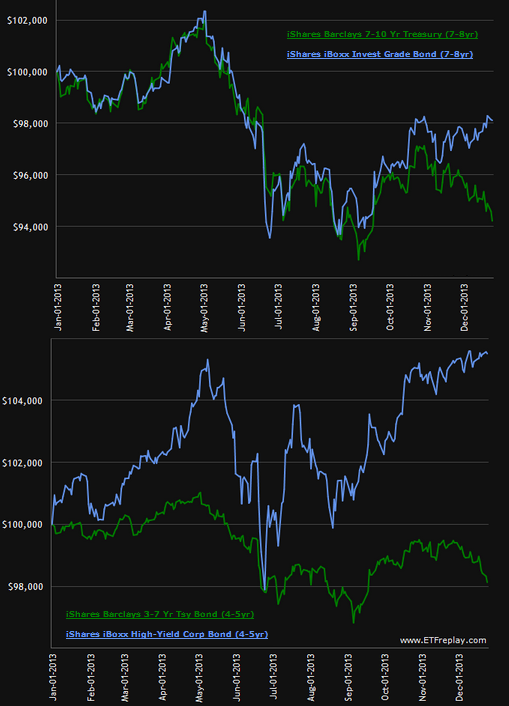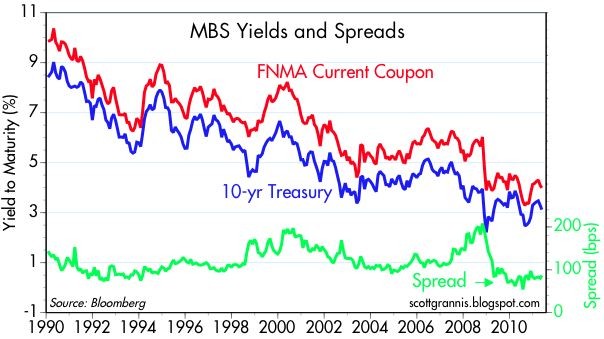Q A LongTerm vs ShortTerm Treasuries Spread the Fed Interest Rates
Post on: 11 Июль, 2015 No Comment

Investment & Financial Knowledge For The Little Guy [Investing, Economics, & Financial topics explained]
Q&A: Long-Term vs Short-Term Treasuries, Spread, the Fed, Interest Rates
Reader Question: What is the correlation between 10 and 30 year Treasuries (Treasurys), or short term vs long term Treasuries? What is the spreads significance? How is the prime rate affected? How is the mortgage rates affected?
There is quite a bit of information behind this question/topic, and a summarized article should be adequate for most investors. However, its not a bad idea for investors to read further on their own, to get a more in-depth understanding than the information posted here. This article should serve as a starting point.
Yield Curve, Cost Of Borrowing (Money)
First, lets discuss the yield curve. Wikipedia has a good definition of the yield curve in finance. They define it as the relation between the interest rate (or cost of borrowing) and the time to maturity of the debt for a given borrower in a given currency .
Most of us already know how to calculate the yield on a debt instrument. It is what the instrument pays per year, expressed as a percentage. The yield is generally dependent on the period of time the money is invested in the instrument. Mathematically, investing for a specified period of time (t ), gives a yield Y(t). Y(t) or just Y. is called the yield curve, and is usually (normally ) an increasing function of t. That means the longer money is invested, the higher the rate/yield (but its not always the case). The yield curve can be known with certainty, only if a specific maturity date exists. Otherwise, it is interpolated.
Different For Everyone
Yield curves can be calculated to describe the cost of borrowing for different countries, institutions, corporations, etc. Everyone borrows at different rates, which is determined by their credit worthiness. Higher yields correspond to higher costs of borrowing, as a higher return is being paid to the lender. Yield curves that correspond to government bonds (or Treasuries) are issued in their own currencies. This is called the government bond yield curve or government curve. The LIBOR curve or swap curve is based on the London Interbank Offered Rate (LIBOR), and is the rate banks use to borrow from one another. Corporate curves correspond to corporate bonds. The mentioned yield curves increase respectively (lowest are government). Yield curves also move on a daily basis as they are traded and reflect the markets reaction to news, events, and investor sentiment.
Increasing Yields With Time (Usually)
As briefly mentioned, yields are usually higher the longer the maturity is. But also note there is usually diminishing marginal growth as well. The reason for this behavior is due to the market anticipating a rise in the risk-free rate. Investors (lender) who delay investing today, may potentially receive a better rate in the future. Long-term investments also expose investors to increased potential of risks that may impact the investment (unforeseen future events, etc). So investors who are willing to invest their money today require compensation for anticipated potential rise in rates (if they were to delay investing) and risk associated with holding longer-term maturities. To compensate, the higher interest rates are offered on long-term investments. Since US Treasuries specify a fixed maturity date, the yield curve can be calculated with certainty. Long-term Treasuries therefore offer higher yields.
Long-Term vs Short-Term, Spreads Significance
The economy faces more uncertainties in the distant future than in the near term, and the underlying notion of investors is that the risk of negative future events (adverse events such as defaults, and higher short-term interest rates) is greater than that of positive future events (lower short-term interest rates and other favorable events). This accounts for the difference in long-term and short-term yields, and it is referred to as the liquidity spread. If investors expect greater volatility/uncertainty in the future (even if interest rates are anticipated to decline), the increase in the risk premium influences the spread and causes an increase in the yield.
For the most part, the yield curve has remained as an increasing one after the Great Depression. Investors expected the economy to grow in the future. With growth, inflation generally rises rather than decrease (deflation) due to increased productivity. See History of The Post WWI Recession for a related discussion of inflation and economic growth.

If short-term interest rates are higher than long-term rates the yield curve will be inverted. This means a situation where something like the 10 year Treasuries (bond) will be at a higher rate than the 30 year Treasuries. The markets anticipation of falling interest rates causes such incidents. Therefore negative liquidity premiums or spreads can exist. However, the prevailing view is that a positive liquidity premium dominates. Therefore only the anticipation of falling interest rates would cause an inverted yield curve situation. Significant inverted yield curves have historically been followed by periods of economic depression. Economists use the yield curve to assess and understand economic conditions.
The Federal Reserve (Central Bank) and Rates
Expectations of inflation also cause expectations that the central bank will attempt to slow down economic growth, in order to keep inflation at a stable and containable rate by tightening monetary policy (raising short term interest rates). Investors demand a risk premium (higher yields) for maturities associated with the future uncertainty regarding inflations impact on the future value of money.
Earlier this year, March 2009, the US Federal Reserve purchased billions of dollars worth of longer term Treasury as well as mortgage-backed securities. Such a move creates artificial demand and causes the yield to decline. The US Federal Reserve keeps the Feds Funds Rate on target by buying or selling Treasuries, mortgage-backed, and agency securities on the open market. The Federal Funds Rate is the short-term interest rate which US depository institutions (banks, savings/loan associations, credit units, etc) lend to each other overnight, within the Federal Reserve system. It is the main benchmark rate. The prime rate is a short-term interest rate in the US banking system, and is tied invariably to the Fed Funds Rate. Therefore a decline in the rate of the long-term government bonds (treasuries), affects other borrowing costs. Therefore, mortgage and other long-term borrowing rates will decline as well.
For further reading, Wikipedia has a pretty good summary of the yield curve, and yield curve theories.
Other economic related articles:
Investment & Economic Outlook 2009














